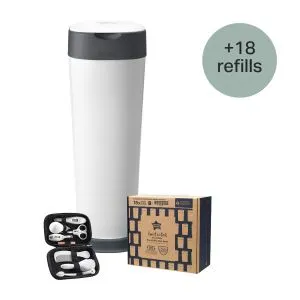
Ultimate XL Nappy Disposal Bundle with 18 Refills
Bundle & Save 40%
Subscription orders can be cancelled at anytime. Free delivery on all subsequent subscription orders. Find out more about subscriptions.
They’re easy and fuss free
Your products are automatically sent to you
You save up to 10% when you sign up for a subscription
You can cancel at any time

Although it can take a little while to get used to, being able to hand express breast milk is a very useful skill to have. Once you've mastered it, you'll be able to express anywhere without a pump. It can also help you to stimulate your breast milk supply or encourage a good latch with your baby.
If you're a new parent who wants to learn the art of hand expressing breast milk without a pump, you've come to the right place. This guide will provide you with essential steps and helpful tips to ensure that you have all the information you need to express with ease. So, read on to discover how to best hand express breast milk.
Expressing breast milk by hand involves gently squeezing your breast to get breast milk out and then collecting it in a sterile container, ready to go into storage or to feed to your baby. It can be useful if you don't have a breast pump or want some quick relief from engorgement.
You can start expressing colostrum by hand before your baby arrives from around the 36th or 37th week of your pregnancy. Some parents are only able to collect a small amount at first, but getting started with hand expressing during pregnancy is great practice for when your breast milk fully comes in.
Although using an electric breast pump speeds up the process of expressing breast milk and can help you express more milk, some parents find that expressing breast milk by hand is also a convenient and comfortable option.
Let's run through the process step by step.
First, thoroughly wash your hands with soap and warm water and then dry them with a clean towel. You should always wash your hands before expressing and handling breast milk.
Then, make sure you have a sterilised cup, bowl, or a baby bottle to collect your expressed breast milk in.
Find a comfortable seat where you feel supported and relax with a drink. Perhaps listening to a podcast or watching an episode of your latest TV series will help you to relax.
Gently massaging your breasts stimulates the release of oxytocin - an essential lactation hormone that's released while you're expressing or breastfeeding. Oxytocin helps to release your breast milk and can also help you to feel calm.
Then it's time to get into position. The NHS recommends that you position your finger and thumb opposite one another, with your thumb at 12 o'clock and finger at 6 o'clock on your breast. This is known as the C-hold.
You may find that it takes a few minutes for your breast milk or colostrum to start to slowly drip out. Try to be patient and build up a rhythm that's comfortable for you.
This will encourage milk from other areas. Once your milk is flowing, you can express from a different area by moving your hands around your breast.
When you've expressed all the milk you can from one boob, repeat the process on the opposite one, then go back to the first breast. You can repeat this process as many times as feels comfortable.
Once you're done, you can either feed your baby the expressed milk right away using a bottle or safely store it in the fridge or freezer to be used at a later date.
The amount of time it takes to hand express milk depends entirely on the person who's expressing - the truth is, no experience is the same!
If you just want to express to provide some light relief, hand expression can take five minutes per breast. But if you want to express a full feed, then it may take between 10 and 30 minutes per breast.
If you're going to be away from your baby for whatever reason, or want your partner to feed them with a bottle so you can have a break from breastfeeding, then you'll need to express a full feed.
How much is needed varies on the baby's age and how much they typically take per feed. A newborn typically needs 30-60ml, but after four or five weeks, most babies drink 90-120ml (three to four ounces) per feed until around six months. This might increase further up to eight ounces for 10-month-olds.
Yes, manually expressing breast milk by hand is safe from around week 36 of pregnancy. Not only is it safe for mum and baby, but it also comes with various other benefits, like encouraging milk supply and relieving breast engorgement.
Hand expressing alongside using a breast pump can be a great way to boost breast milk production. Research has found it could boost breastmilk output by as much as 48%.
To help establish breast milk production if you're not breastfeeding a newborn, you should aim to hand express between eight and 12 times a day, including at least once during the night.
You can reduce the chance of getting messy while hand expressing by having a muslin cloth positioned under your breast to catch any drips. You can also have a warm, wet cloth close by to clean up afterwards.
Expressing breast milk by hand can be a more reliable method for some people. It's less expensive, quieter and can sometimes offer more privacy.
However, the most important thing is that parents and babies both find an approach that works best for them. This can include a mix of hand expressing, pumping, and breastfeeding. Whatever works for you is best!